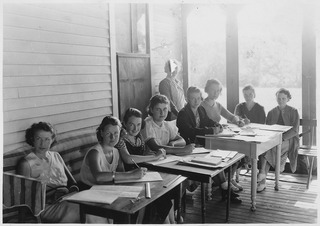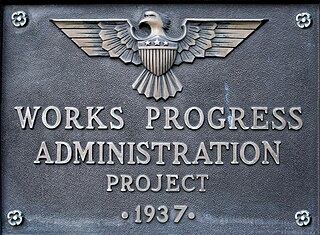 W
WThe New Deal was a series of programs, public work projects, financial reforms, and regulations enacted by President Franklin D. Roosevelt in the United States between 1933 and 1939. It responded to needs for relief, reform, and recovery from the Great Depression. Major federal programs and agencies included the Civilian Conservation Corps (CCC), the Civil Works Administration (CWA), the Farm Security Administration (FSA), the National Industrial Recovery Act of 1933 (NIRA) and the Social Security Administration (SSA). They provided support for farmers, the unemployed, youth and the elderly. The New Deal included new constraints and safeguards on the banking industry and efforts to re-inflate the economy after prices had fallen sharply. New Deal programs included both laws passed by Congress as well as presidential executive orders during the first term of the presidency of Franklin D. Roosevelt.
 W
WThe American Student Union (ASU) was a national left-wing organization of college students of the 1930s, best remembered for its protest activities against militarism. Founded by a 1935 merger of Communist and Socialist student organizations, the ASU was affiliated with the American Youth Congress. The group was investigated by the Dies Committee of the United States House of Representatives in 1939 over its connections to the Communist Party USA. With the group's Communist-dominated leadership consistently supportive of the twists and turns of Soviet foreign policy, the Socialist minority split from the group in 1939. The organization was terminated in 1941.
 W
WThe Black Cabinet, or Federal Council of Negro Affairs or Black Brain Trust, was the informal term for a group of African Americans who served as public policy advisors to President Franklin D. Roosevelt and his wife Eleanor Roosevelt in his terms in office from 1933 to 1945. Despite its name, it was not an official organization. The term was coined in 1936 by Mary McLeod Bethune and was occasionally used in the press. By mid-1935, there were 45 African Americans working in federal executive departments and New Deal agencies.
 W
WThe Defining Moment: FDR's Hundred Days and the Triumph of Hope is a political history book by Jonathan Alter about the first 100 days of Franklin D. Roosevelt's presidency. The book also focuses on how Roosevelt's childhood, personal life, diagnosis of polio, and early political life prepared him for those early days in which he established the New Deal to fight the Great Depression.
 W
WFranklin Delano Roosevelt, often referred to by his initials FDR, was an American politician who served as the 32nd president of the United States from 1933 until his death in 1945. A member of the Democratic Party, he won a record four presidential elections and became a central figure in world events during the first half of the 20th century. Roosevelt directed the federal government during most of the Great Depression, implementing his New Deal domestic agenda in response to the worst economic crisis in U.S. history. As a dominant leader of his party, he built the New Deal Coalition, which defined modern liberalism in the United States throughout the middle third of the 20th century. His third and fourth terms were dominated by World War II, which ended shortly after he died in office.
 W
WThe She-She-She Camps were camps for unemployed women that were organized by Eleanor Roosevelt (ER) in the United States as a counterpart to the Civilian Conservation Corps (CCC) programs designed for unemployed men. ER found that the men-only focus of the CCC program left out young women who were willing to work in conservation and forestry and to sign up for the six-month programs living away from family and close support. She lobbied for a sister organization to the CCC that would be for young women. Eleanor Roosevelt proposed that this would consist of camps for jobless women and residential worker schools. The She-She-She camps were funded by presidential order in 1933. Labor Secretary Frances Perkins championed one such camp after ER held a White House Conference for Unemployed Women on April 30, 1934, and subsequently ER's concept of a nationwide jobless women's camp was achieved. While the public largely supported the New Deal programs and the CCC was a huge success, the women's version barely topped 5,000 women annually by 1936 and overall served 8,500 as a result of ER's support.
 W
WHilda Worthington Smith was an American labor educator, social worker, and poet. She is best known for her roles as first Director of the Bryn Mawr Summer School for Women Workers in Industry and as a co-founder of the Affiliated Schools for Workers, though she also had a long career in government service supporting education for underserved groups including women, labor workers, and the elderly.
 W
W"The switch in time that saved nine" is the phrase, originally a quip by humorist Cal Tinney, about what was perceived in 1937 as the sudden jurisprudential shift by Associate Justice Owen Roberts of the U.S. Supreme Court in the 1937 case West Coast Hotel Co. v. Parrish. Conventional historical accounts portrayed the Court's majority opinion as a strategic political move to protect the Court's integrity and independence from President Franklin Roosevelt's court-reform bill, which would have expanded the size of the bench up to 15 justices.
 W
WThe Living New Deal is a research project and online public archive documenting the scope and impact of the New Deal on American lives and the national landscape. The project focuses on public works programs, which put millions of unemployed to work, saved families from destitution, and renovated the infrastructure of the United States. What is more, most New Deal public works - schools, roads, dams, waterworks, hospitals and more - continued to function for decades and tens of thousands still exist today.